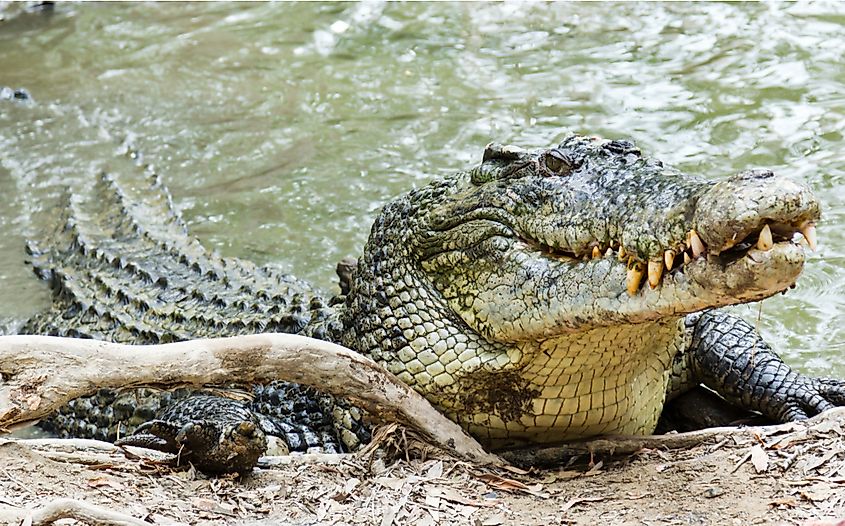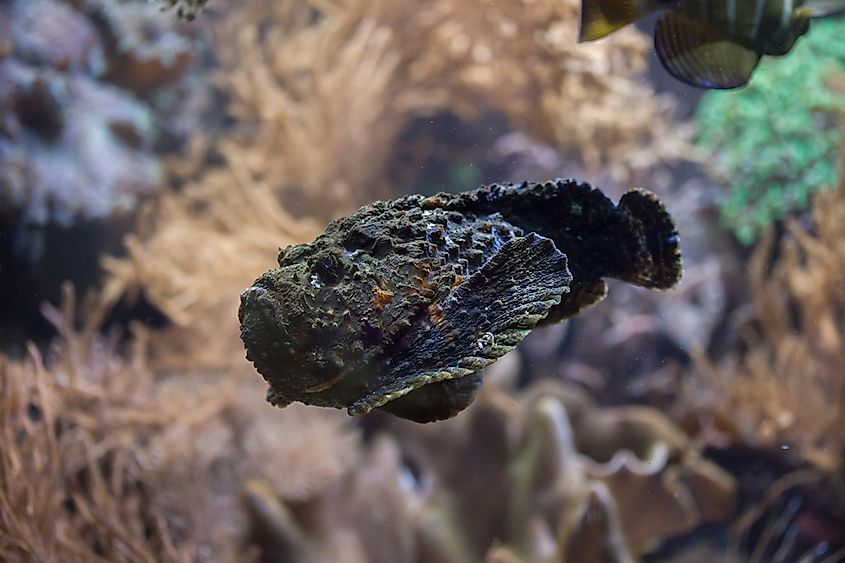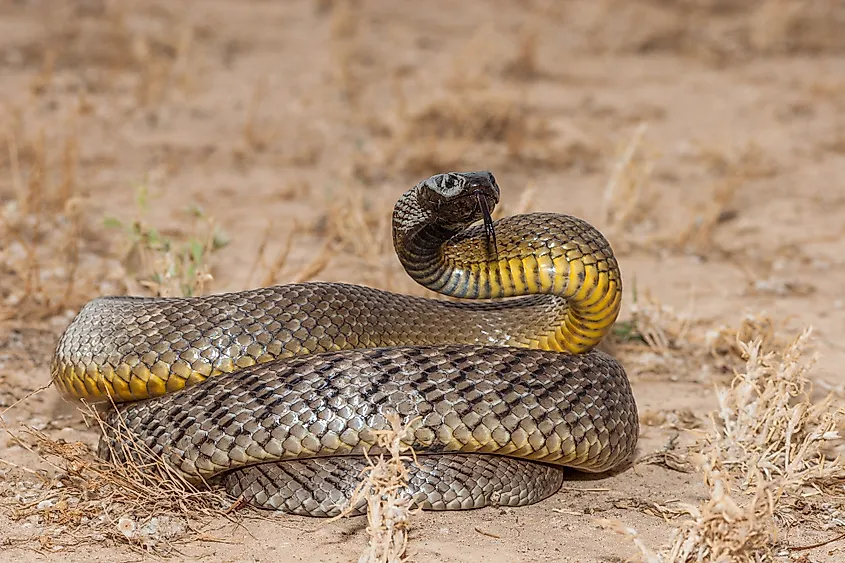
The Most Dangerous Animals In The World
The world is in no short supply of dangerous animals. All across our planet, no matter where you are, there is a good chance there is at least one wild animal that is more than capable of harming you.
Animals can be dangerous in various ways. For instance, deer and moose kill thousands each year in the United States in car collisions. However, the following animals will be considered "dangerous" not by the number of humans who are killed each year but by how objectively deadly and ferocious a certain animal is, regardless of how likely it is to kill a person.
Blue-Ringed Octopus

- Size - 4.3 in (11cm)
- Weight - 2.8 oz (80g)
- Where to find - Pacific Ocean
Despite only being the size of a golf ball, the blue-ringed octopus is considered to be one of the deadliest animals on Earth. The danger of the blue-ring octopus does not come from razor-sharp claws or fangs but rather its highly venomous bite.
The blue-ringed octopus is relatively mild-tempered but can spring into action the moment it feels threatened. Its bite is often painless, and many victims are totally unaware they have even been bitten before symptoms of the toxins begin to set in.
The toxin attacks the nervous and preparatory system eventually leading to paralysis and organ failure. To make matters worse, there is currently no cure (antivenin) for the bite of the blue-ringed octopus. The average blue-ringed octopus carries enough venom to kill 26 adult humans with ease. Native to the waters of Australia and Japan, make sure to steer clear of these unassuming killers.
Saltwater Crocodile

- Length - 20ft (6 m)
- Weight - 3,300 lb (1496 kg)
- Where to find - Southeast Asia/Australia
The infamous saltwater crocodile can be found across India, Southeast Asia, and Northern Australia. They are the largest reptiles on Earth and can grow up to a staggering 20ft (6 m) long and weigh as much as 3,300 lb (1,000-1,500 kg.)
Saltwater crocodiles are carnivores and are known to eat just about anything that becomes available. Even humans on occasion. These animals are not known to stalk their prey but rather wait near lakes and rivers to set an ambush.
The bite of the saltwater crocodile is considered to be one of the strongest in the animal kingdom. Once they get ahold of their prey, their jaws lock shut, making escape nearly impossible. The crocodile will then drag its victim into what is called a "death roll." This is done to exhaust, confuse, and dismember anything unlucky enough to have fallen into its grasp.
Stonefish

- Length - 11.8 in (30cm)
- Weight - 5lbs (2 kg)
- Where to find - Indian Ocean/Pacific Ocean/Caribbean Sea
The stonefish is a species of fish that is commonly found throughout the Indian and Pacific Oceans, as well as the Caribbean Sea. At first glance, a stonefish might look harmful, but they are incredibly dangerous.
The sting of a stonefish is toxic to humans and can often be fatal if not immediately treated. Stings are often accompanied by intense pain, labored breathing, damage to the cardiovascular system, and convulsions.
Stonefish stings are not usually the result of a deliberate attack but rather due to a diver or snorkeler who was not watching their footing and either stepped on or leaned into a stonefish that was resting against a rock.
Inland Taipan

- Length - 6.5ft (2m)
- Weight - 4.5 lbs (2 kg)
- Where to find - Australia
The inland taipan is regarded as one of the most dangerous snakes in the world. This especially poisonous snake lives primarily in the Australian Outback. The inland taipan hunts small mammals such as mice and rabbits, making it very deadly to humans as well.
A single bite from the inland taipan contains enough toxins to kill 100 full-grown humans. Incredibly fast-moving and agile, when either hunting or provoked, the inland taipan often attacks multiple times. Thankfully, these snakes are considered to be quite shy and tend to avoid contact with people.
Due to the inhospitable environment in which the inland taipan lives, the actual number of human encounters with this animal is quite low. However, this does not minimize how lethal the inland taipan can be in those rare instances a human stumbles across one.
Hippopotamus

- Height - 16ft (4.8m)
- Weight - 3,300lbs (1,500 kg)
- Where to find - Africa
The hippopotamus is the third largest land mammal on the planet and can weigh as much as 3,300 lbs (1,500 kg.) The dangerous nature of the hippos has become common knowledge in recent decades. Despite having a seemingly harmless look to them, they are incredibly aggressive and are known to attack and kill humans regularly.
Hippo attacks usually occur against small watercraft that unknowingly venture into its territory in a river or lake. A full-sized hippo can easily capsize a small boat or raft using its sheer size and weight to throw its crew overboard.
Once in the water, humans are at the mercy of these animals. Using its large tusks, hippos usually bite onto humans and then drown them. There are, on average, 500 deaths attributed to hippo attacks each year.
Polar Bear

- Height - 8ft (2.4m)
- Weight - 600lbs (272 kg)
- Where to find - Arctic Region
Found in the frozen tundra of the Arctic, the polar bear is at the top of the food chain. The polar bear is the largest of all bears and the largest land carnivore in the world. The polar bear diet consisted almost exclusively of seals that inhabit the Arctic region.
Due to the remoteness of their habitat, polar bears and human encounters are rare. But their lack of human interaction comes at a cost. Due to their lack of contact with people, they are nearly fearless toward humans. The tricks of standing tall and making noise might work on black and brown bears, but polar bears will just kill you instead.
Their sense of smell is astounding and can smell humans from miles away if the wind permits it. Polar bears have been known to hunt, stalk, and kill humans. This aggressiveness is only intensified if the bear has not eaten and is close to starvation.
Grizzly Bear

- Height - 6.5 ft (2m)
- Weight - 858lbs (207 kg)
- Where to find - Canada/United States
The smaller cousin of the polar bear, the North American brown bear, also known as a grizzly bear, can be found across Western and Northern Canada, as well as Alaska. In fact, of the 60,000 grizzly bears that are thought to exist, more than half reside within Alaska.
Grizzlies are known to eat salmon and berries and scavenge food from dead animals such as deer when given the opportunity. Grizzly bears are not particularly aggressive towards humans but can be quite hostile, especially when they travel with cubs.
Grizzly bears, despite their large size, are deceptively fast. A bear will often charge during an attack and begin to maul whatever it sees as a threat. Using its razor-sharp claws and teeth, grizzly bears attack until they feel as though someone is no longer a threat. It is often said it is best to play dead if you ever encounter a grizzly in the wild rather than try to scare or intimidate.
Silverback Gorilla

- Height - 5ft (1.5m)
- Weight - 440lbs (200 kg)
- Where to find - Africa
Living in Central Africa, the silverback gorilla is perhaps one of the most well-known animals on Earth. The largest of all primates, silverback gorillas in particular, are famous for their incredible strength and potential for ferocious attack if ever provoked.
If a silverback gorilla is ever felt threatened they usually respond in a sudden explosion of violence. There is little in the way of predatory instinct present in these animals. Using their strength they often maul, bite, and literally tear apart humans or other primates who threaten them.
Despite their size, gorillas are surprisingly shy and timid around humans, often choosing to ignore them outright. As long as humans act submissive and non-threatening to gorillas, then the chance of an attack is very rare.
Lion

- Height - 7ft/8ft (2m/2.4m)
- Weight - 300lbs/400lbs (136kg/181kg)
- Where to find - Africa/India
Hunting in large packs called prides, the ferocity and killer instinct of lions is unrivaled. The second-largest living felines in the world, what remains of the once widespread diaspora of lions is now relegated to Central Africa and Western India. While tigers are larger, they lack the instinct to hunt in packs.
Lions mostly live off eating the various mammals that inhabit the African savannah. The speed, strength, and ruthlessness of lions are truly something to behold. It is often the female lions that act as the primary hunters of pride.
Lions attack humans uncommonly, but they are not unheard of. Each year, primarily in Africa, nearly 250 people are killed by lions. These human fatalities are often the result of starving or threatened lions. The mythos of the "man-eating" lions in modern pop culture stems from the infamous group of lions known as the Tsavo Man-Eaters, a pride of lions who explicitly attacked railroad workers in Kenya in the 1890s, killing at least 35 people.
Elephants

- Height - 11ft (3.3m)
- Weight - 7t (6350 kg)
- Where to find - Africa/Asia
Similar to lions, elephants once roamed across much of Africa and Asia but now only reside in small pockets in Central Africa, India, and parts of Southeast Asia. The largest land mammal on Earth, elephants can grow as tall as 11ft tall (3.3m) and weigh a staggering 7 tons (6350kg.)
Traveling in large herds, elephants are strictly herbivores and eat fruit and vegetation for sustenance. Usually thought to be passive animals, they are known to attack humans, especially when they feel as though their young are under threat.
Elephants will often conduct false charges against an aggressor in hopes of driving them away. If that fails an angry elephant will tramble and maul their target. Using their incredible weight in their favor they can crush and maul a target with ease.
Conclusion
Despite being dangerous, animal attacks are regarded to be rare. In most cases, animal attacks can be avoided by taking the proper precautions and making sure that you are not seen as a threat. As long as a person is respectful and at a safe distance there is no reason why most of these stunning animals cannot be appreciated and studied.
The World's Deadliest Animals
| Animal Name | Habitat |
|---|---|
| Blue-Ringed Octopus |
Coastal waters and tide pools |
| Saltwater Crocodile |
Saltwater rivers and estuaries, freshwater
|
| Stonefish |
Coral reefs and rocky sea beds
|
| Inland Taipan | Dry soil plains |
| Hippopotamus |
Freshwater rivers and lakes
|
| Polar Bear |
Arctic sea ice regions
|
| Grizzly Bear |
Forests, mountain regions, alpine meadows
|
| Silverback Gorilla |
Tropical rainforests
|
| Lion |
Savannas and grasslands
|
| Elephant |
Savannahs, forests, and grasslands
|
| Orca |
Ocean and coastal waters
|
| Great White Shark |
Coastal surface waters
|
| Chironex Fleckeri |
Coastal waters and estuaries
|
| Wolf |
Forests, grasslands, deserts, arctic tundras
|
| Tiger |
Tropical rainforests, grasslands, savannas
|
| Domesticated Dog |
Human habitations
|
| Coyote |
Prairies, deserts, and forests
|
| Dingo |
Forests, grasslands, and deserts of Australia
|
| Mountain Lion |
Forests, mountain ranges, desert edges
|
| Snow Leopard |
Alpine and subalpine zones
|











